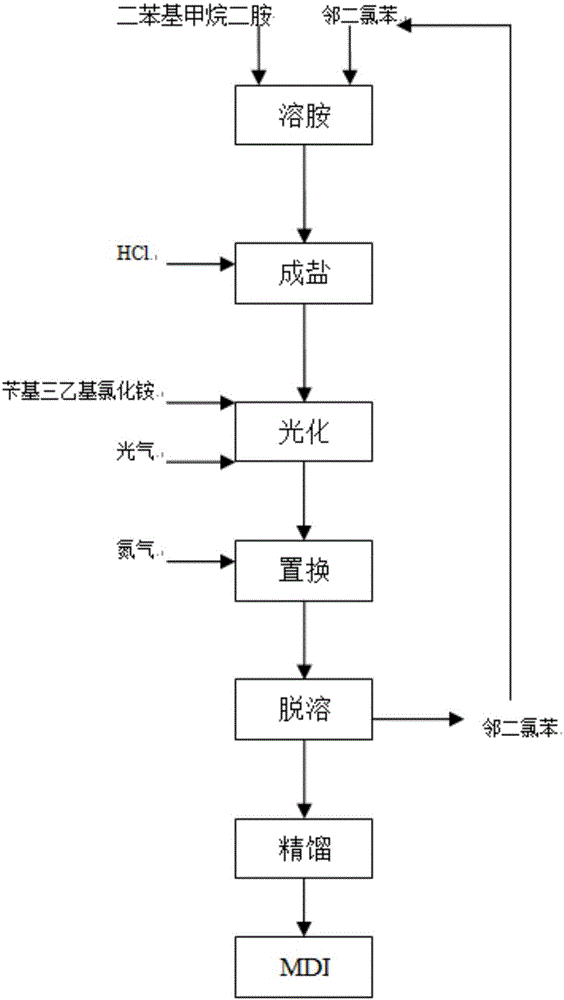Preparing method of MDI
An organic solvent and solution technology, applied in the field of preparation of organic compounds, can solve the problems of non-phosgene method retention, difficulty in large-scale production, and many side reactions, and achieve the effects of accelerating the reaction rate, shortening the production cycle, and reducing the reaction temperature
- Summary
- Abstract
- Description
- Claims
- Application Information
AI Technical Summary
Problems solved by technology
Method used
Image
Examples
Embodiment 1
[0034] Put 30g of diphenylmethanediamine and 360g of o-dichlorobenzene into a 500ml four-neck flask equipped with a stirring, thermometer, gas guide tube and condenser tube, raise the temperature to 40~45°C, and pass in dry HCl gas while stirring , adjust the system pH=2~3. Add 0.3g of benzyltriethylammonium chloride, raise the temperature to 105~110℃, and pass phosgene under vigorous stirring, pass phosgene at 105~110℃ for 1.5h, Pass phosgene at ~140°C for 2 hours, and finally pass phosgene at 155-160°C until the solution is transparent. Then cool down to 40~45°C, and pass through dry nitrogen for 2h. Then the solvent is removed under reduced pressure, and then rectified under reduced pressure to obtain pure MDI.
[0035] 32.5g of pure MDI was obtained in the experiment, the content was 99.3% by gas spectrometry analysis, and the yield was 85.8%.
Embodiment 2
[0037] The process steps are the same as in Example 1, except that the feeding amount of diphenylmethanediamine is 50 g, that of o-dichlorobenzene is 600 g, and that of benzyltriethylammonium chloride is 0.5 g.
[0038] 55.6g of pure MDI was obtained in the experiment, the content was 99.4% by gas spectrometry analysis, and the yield was 88.1%.
Embodiment 3
[0040] The process steps are the same as in Example 1, except that the feeding amount of n-diphenylmethanediamine is 100 g, that of xylene is 1200 g, and that of benzyltriethylammonium chloride is 1 g.
[0041] 113g of pure MDI was obtained in the experiment, the content was 99.4% by gas spectrometry analysis, and the yield was 89.5%.
PUM
 Login to View More
Login to View More Abstract
Description
Claims
Application Information
 Login to View More
Login to View More - R&D
- Intellectual Property
- Life Sciences
- Materials
- Tech Scout
- Unparalleled Data Quality
- Higher Quality Content
- 60% Fewer Hallucinations
Browse by: Latest US Patents, China's latest patents, Technical Efficacy Thesaurus, Application Domain, Technology Topic, Popular Technical Reports.
© 2025 PatSnap. All rights reserved.Legal|Privacy policy|Modern Slavery Act Transparency Statement|Sitemap|About US| Contact US: help@patsnap.com

